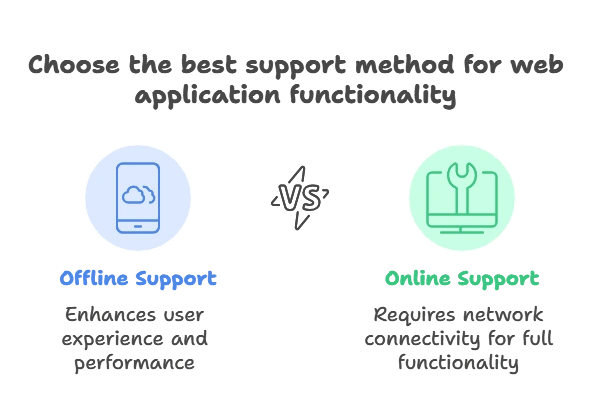Offline Support and Service Workers in Node.js
Offline support is critical for modern web applications, especially when dealing with unreliable or intermittent network connections. It ensures a seamless user experience by enabling apps to work without an internet connection. In this chapter, we will explore how to provide offline support using service workers, specifically in the context of Node.js. We’ll cover how service workers work, caching strategies, synchronization of data, and examples to implement offline-first strategies.
What is Offline Support?
Offline support allows a web application to function even when there is no network connectivity. This involves caching resources (HTML, CSS, JS files, images, etc.) and storing data locally to allow users to continue using the app offline.
Why is Offline Support Important?
- Better User Experience: Users can interact with the application even without internet access.
- Improved Performance: Resources can be served from local cache, making the app faster.
- Resilience: The app remains functional even with unstable network conditions.

Understanding Service Workers
What is a Service Worker?
A service worker is a script that the browser runs in the background, separate from a web page, enabling features that do not require a web page or user interaction, like caching resources and syncing data. It acts as a proxy between the browser and the network and can intercept network requests to provide offline functionality.
Key Features of Service Workers:
- Intercept Network Requests: It can listen to network requests and decide whether to serve them from the cache or fetch them from the network.
- Caching Resources: Allows you to store static files in the cache so that the application works offline.
- Background Sync: Synchronize data with the server when the connection is restored.
- Push Notifications: Service workers can handle push notifications, even when the web page is closed.
Service Worker Lifecycle
- Registering: You register the service worker in the main JavaScript file of your app.
- Installing: This is where you can cache assets.
- Activating: Cleaning up old caches and ensuring the service worker takes control.
- Fetching: The service worker intercepts all network requests and serves from the cache if the resources are available.
// Registering a service worker in your Node.js app
if ('serviceWorker' in navigator) {
window.addEventListener('load', () => {
navigator.serviceWorker.register('/service-worker.js')
.then((registration) => {
console.log('Service Worker registered with scope: ', registration.scope);
})
.catch((error) => {
console.error('Service Worker registration failed:', error);
});
});
}
Setting Up Offline Support in Node.js
Step 1: Create a Basic Node.js App
Start by creating a simple Node.js application with Express to serve your static files.
const express = require('express');
const app = express();
const path = require('path');
// Serve static files
app.use(express.static(path.join(__dirname, 'public')));
app.get('/', (req, res) => {
res.sendFile(path.join(__dirname, 'public', 'index.html'));
});
app.listen(3000, () => {
console.log('App is running on port 3000');
});
Step 2: Creating the Service Worker
Create a service-worker.js file in your public folder.
const CACHE_NAME = 'v1';
const urlsToCache = [
'/',
'/styles.css',
'/script.js',
'/offline.html'
];
// Installing the service worker
self.addEventListener('install', event => {
event.waitUntil(
caches.open(CACHE_NAME)
.then(cache => {
console.log('Opened cache');
return cache.addAll(urlsToCache);
})
);
});
// Fetching the assets
self.addEventListener('fetch', event => {
event.respondWith(
caches.match(event.request)
.then(response => {
if (response) {
return response; // return from cache
}
return fetch(event.request); // fetch from network
})
.catch(() => caches.match('/offline.html')) // serve offline page if offline
);
});
Step 3: Update Caching Strategies
You can implement various caching strategies based on your app’s requirements. Here are some common strategies:
- Cache First: Serve resources from the cache if they exist, otherwise fetch from the network.
- Network First: Try fetching from the network first, then fall back to cache if the network is unavailable.
- Stale While Revalidate: Serve from the cache while updating the cache in the background.
Example: Network First with Fallback to Cache
self.addEventListener('fetch', event => {
event.respondWith(
fetch(event.request)
.then(response => {
// Save the response in the cache
return caches.open(CACHE_NAME).then(cache => {
cache.put(event.request, response.clone());
return response;
});
})
.catch(() => caches.match(event.request)) // fallback to cache if network fails
);
});
Advanced Topics
1. Background Sync
Background sync is a feature that allows you to retry requests when the network is available again. For example, submitting a form when offline can be synced once the connection is restored.
self.addEventListener('sync', event => {
if (event.tag === 'syncFormData') {
event.waitUntil(syncFormData());
}
});
function syncFormData() {
// Logic to sync form data to server
console.log('Form data synced');
}
2. Push Notifications
Service workers can be used to send push notifications to the user, even when they are not actively using the app.
self.addEventListener('push', event => {
const options = {
body: 'New message received!',
icon: '/icon.png'
};
event.waitUntil(
self.registration.showNotification('Push Notification', options)
);
});
Service workers provide powerful capabilities to make your Node.js application work offline, enhancing the user experience. They enable efficient caching strategies, background synchronization, and push notifications, which allow the app to work seamlessly without network connectivity. By following this chapter, you now understand the basics and advanced concepts of offline support in Node.js using service workers. This foundational knowledge will help you implement offline-first strategies in your applications, ensuring better performance, resilience, and user satisfaction. Happy coding !❤️
